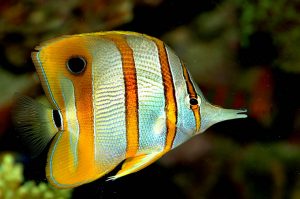I received the following email recently:
Dear Advancedaquarist.com,
I have been searching all over the internet for some expert advice
about how to control the Aiptasia Anemone (AA) outbreak in my tank. I
have tried all of the standard fare of Lemon juice, calcium hydroxide w/
vinegar solution, part A or B of B-Ionic buffer and all of them have not
proven very effective. I have tried putting it on the AA, injecting it
into them (where I can) and some die off but some come back. I guess so
far I have had the best results with the calcium hydroxide w/vinegar
solution and just putting it onto the AA (not injecting) but then this
has been “crashing” my Ca levels in the tank after treatment(of course).
I have searched the articles on your site also but only found a few
suggestions on a forum page which are the same as the rest.I have a 200 gal saltwater w/ 75 galrefugium. The tank is extremely
healthy with a variety of fish and corals and all water parameters are
perfect (except the Ca after I do an AA treatment). I have some very
large pieces of live rock that are epoxied together so removing rocks for
treat of unreachable AAs is not an option. I am devising a plan to make a
syringe / tube that will allow me to get at some of these unreachable AAs
but I want to get some consensus on a proven effective treatment, if
available. I suspect that there is one large AA in one of the caves in my
live rock that I cannot see that may be continuing to propagate as I
understand the small ones are unable to. I think I have located it too. I
would like some advice on this subject too and see if there is anything
that may help prevent propagation? The small ones continue to keep
“popping” up in small cracks and crevices.Again, all of the forums I have gone to keep giving me the same advice
but I am not confident that the advice is coming from seasoned veterans
of the business. To that, I wanted to see if you, or any of your
resources, may have some expertise on this subject and if you might be
able to consult with them for some advice on this issue?This has become a weekly battle for me now for the last three months
so I am getting a little frazzled at this point. I want to thank you in
advance for any help or direction you can give me.Kindest Regards,
Brian Goodhead
My response to Brian’s question will reveal my basic attitude, developed
over 25-years of reef keeping, that the best solution to his and many
problems that plague reef keepers is to rely on natural methods. In this
case, to find predators that eat Aiptasia sp. anemones, rather
than using the various chemical concoctions available in our hobby
today.
Aquarists have had success with the the aeolid nudibranch Berghia
verrucicornis. See the following web site, http://www.seaslugforum.net/factsheet.cfm?base=bergverraq.html.
Other aquarists have had success with Lysmata wurdemanni, commonly
called the peppermint shrimp. See the following,
http://www.marinedepotlive.com/peppermint-shrimp—lysmata-wurdemanni–inverts–shrimp.html.
Butterflyfish, probably most species, and some angelfish will readily
eat Aiptasia. Because many of these fish will also eat soft and
hard corals, especially LPS corals they are a risky addition to a reef
tank. However, I have had considerable success with the Copperbanded
butterflyfish, Chelmon rostratus. See the following link, http://www.amonline.net.au/fishes/fishfacts/fish/crostratus.htm.
With a tank your size, I would recommend the butterflyfish. The sea slug
and shrimp would tend to get lost in a 200-gallon tank. My experience, as
well as others, is that Chelmons rarely bother anything other than
anemones. The biggest problem with this butterflyfish is that after it has
eaten all the Aiptasias, unless the aquarist can supply it with food that
will sustain it, it will starve. I have been successful over the years by
feeding them frozen mysis shrimp and live tubifex worms. Many can also be
trained to eat chopped sea food. However, in a community tank they don’t
always compete well, so get one that is eating well, fat, and of good size.
In my experience, smaller ones do not compete well for food. If you succeed
in establishing a Chelmon Rostratus you will never have to concern
yourself with Aiptasias again, and in the bargain, will have a
very beautiful fish. See photo of mine!










0 Comments